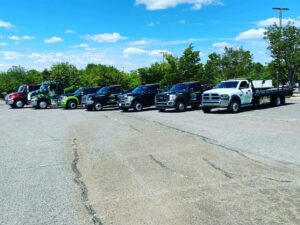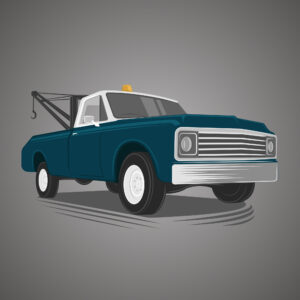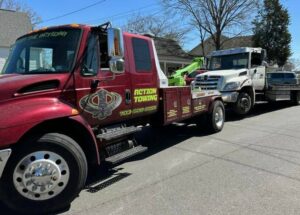The Importance of Towing in Modern Society.

Towing technology has played a crucial role in modern society, impacting transportation, logistics, and emergency services. It ensures the smooth flow of traffic, reduces accidents, and aids in the movement of heavy or disabled vehicles, significantly contributing to the logistics industry, global trade, and road safety. The history of towing technology reflects the evolution of societal safety and economic growth (Guys Towing Service, 2023; Cox Mazda, 2023; Custer Products, 2023; The Atlantic, 2011).
In the logistics industry, towing technology has been pivotal in freight transportation, significantly contributing to global trade and commerce. Moreover, in situations of vehicular breakdowns or accidents, towing services are indispensable, providing prompt assistance and enhancing road safety. Thus, the advancements in towing technology have not only improved efficiency but also greatly influenced societal safety and economic growth.
Early Developments in Towing Technology
 Ancient civilizations relied on animals to tow heavy loads, but the late 19th century introduced automobiles, shifting towing methods towards motorized vehicles. Initially, ropes and chains were common for towing, but the early 20th century saw the introduction of tow trucks with flatbed or wheel-lift designs, significantly improving the safety and efficiency of towing. The mid-20th century brought hydraulic tow trucks, using pressurized fluid for lifting vehicles, enhancing efficiency and safety. In the late 20th century, computerization influenced towing with integrated dispatch systems and GPS technology for precise tracking and navigation. The 21st century witnessed innovations like self-loading wreckers and advanced towing software, along with the emergence of electric and hybrid tow trucks for sustainability (Guys Towing Service, 2023; Cox Mazda, 2023; Custer Products, 2023).
Ancient civilizations relied on animals to tow heavy loads, but the late 19th century introduced automobiles, shifting towing methods towards motorized vehicles. Initially, ropes and chains were common for towing, but the early 20th century saw the introduction of tow trucks with flatbed or wheel-lift designs, significantly improving the safety and efficiency of towing. The mid-20th century brought hydraulic tow trucks, using pressurized fluid for lifting vehicles, enhancing efficiency and safety. In the late 20th century, computerization influenced towing with integrated dispatch systems and GPS technology for precise tracking and navigation. The 21st century witnessed innovations like self-loading wreckers and advanced towing software, along with the emergence of electric and hybrid tow trucks for sustainability (Guys Towing Service, 2023; Cox Mazda, 2023; Custer Products, 2023).
The progression of towing technology through different periods mirrors the rapid advancements in automobile and engineering technologies. Post the advent of tow trucks in the early 20th century, the mid-century saw the introduction of hydraulic tow trucks which utilized the power of pressurized fluid to lift broken-down vehicles. This innovation brought about a remarkable increase in the efficiency and safety of towing operations.
As we entered the digital age in the late 20th century, computerization began to influence towing technology. Integrated dispatch systems emerged, allowing towing companies to coordinate their operations more effectively. GPS technology also started being incorporated into tow trucks, facilitating accurate location tracking and efficient navigation.
In the 21st century, towing technology continues to evolve with innovations like self-loading wreckers, which minimize human intervention, and advanced towing software that helps manage business operations. Furthermore, the advent of electric and hybrid tow trucks promises a more sustainable future for the towing industry.
Today’s towing technology integrates various aspects such as automation, digital connectivity, and environmental sustainability, reflecting the multi-faceted evolution of this field. As we move forward, the continuous pursuit of innovation in towing technology is expected to cater to the growing demands of a globally connected and environmentally conscious society.
Early Days of Towing Technologies: Horsepower and Simple Machines
 In early towing, horses provided the primary source of power. Horses were robust, reliable, and could traverse diverse terrains, making them the ideal choice for early towing needs. They were typically harnessed to whatever needed moving and could handle everything from logs to entire buildings with relative ease.
In early towing, horses provided the primary source of power. Horses were robust, reliable, and could traverse diverse terrains, making them the ideal choice for early towing needs. They were typically harnessed to whatever needed moving and could handle everything from logs to entire buildings with relative ease.
Simple machines like wheels and pulleys complemented horsepower, allowing for more efficient towing operations. This integration laid the foundation for later advancements in towing technology, showcasing early societies’ resourcefulness and ingenuity (Wikipedia, 2023; Northeast AAA, 2023; Hiway Towing, 2023).
Early on, simple machines such as wheels and pulleys also played a crucial role in towing operations. The wheel, one of the oldest and most significant inventions in human history, was utilized in various ways. Simple carts and wagons were utilized to transport heavy loads, with horses providing the necessary motive power. As these vehicles evolved, they became more sophisticated, leading to the creation of specialized horse-drawn vehicles designed specifically for towing.
Moreover, pulleys, a type of simple machine that uses a wheel and rope to lift or move heavy objects, were frequently used in conjunction with horsepower. The combination of horses and pulleys could move larger and heavier objects than horses alone, greatly increasing the effectiveness of early towing operations.
Thus, the integration of horsepower and simple machines laid the foundation of early towing technologies. These methods, although primitive by today’s standards, set the stage for the technological advancements that were to follow in the field of towing. Their use demonstrated the ingenuity and resourcefulness of early societies, and their influence can still be seen in modern towing practices.
Towing Carriages and Carts
 Horses towing carriages and carts represented a rudimentary yet effective form of towing technology. These animals, often working in pairs or teams, were directed by a handler using reins and verbal commands. Over time, carriages and carts evolved with improved wheel construction and suspension systems, contributing to the development of more sophisticated towing systems (Northeast AAA, 2023; Hiway Towing, 2023).
Horses towing carriages and carts represented a rudimentary yet effective form of towing technology. These animals, often working in pairs or teams, were directed by a handler using reins and verbal commands. Over time, carriages and carts evolved with improved wheel construction and suspension systems, contributing to the development of more sophisticated towing systems (Northeast AAA, 2023; Hiway Towing, 2023).
Horses, often working in pairs or teams, would be directed by a driver or handler who controlled their speed and direction using reins and verbal commands. Due to the strength and endurance of horses, they were capable of towing these vehicles over considerable distances, making this method of transportation pivotal in the trade and transportation systems of early societies.
The design of carriages and carts evolved over time, with improvements in wheel construction and the addition of suspension systems, providing smoother and more efficient movement. Despite the technological simplicity, this system of horse-drawn carriages and carts laid the groundwork for the complex towing systems we see in use today.
Inventions and Applications of Simple Machines in Towing
Simple machines, including pulleys and levers, have been integral to the development of towing technology. Pulleys increased the pulling power of horses or human labor, while levers were used to lift heavy objects onto towing carriages or carts. These simple machines evolved into more complex systems, increasing their utility in towing operations and influencing modern towing equipment design (Wikipedia, 2023; Northeast AAA, 2023; Hiway Towing, 2023).
Similarly, the lever, another simple machine, played a significant role in early towing operations. The principle of the lever — that effort can be magnified through the mechanical advantage of a long beam pivoted at one end — has been harnessed since prehistoric times. In towing, levers were used to lift heavy objects onto towing carriages or carts, making the loading process easier and more efficient.
As societies advanced, these simple machines were combined and adapted into more complex systems, increasing their utility in towing operations. The integration of pulleys and levers into towing equipment enabled the lifting and moving of progressively heavier loads, paving the way for the sophisticated towing technologies that are in use today. The principles behind these simple machines continue to inform the design of modern towing equipment, serving as a testament to their enduring utility and the genius of their invention.
The Limitations of Early Towing Capabilities
Early towing technologies had limitations, such as the physical capabilities and endurance of horses, weather conditions, and terrain. Simple machines like pulleys and levers required manual labor and maintenance, impacting efficiency. Loading and unloading heavy objects onto towing carriages or carts was laborious and time-consuming. These limitations drove innovations and advancements, leading to motorized vehicles and specialized towing equipment (Wikipedia, 2023; Northeast AAA, 2023; Hiway Towing, 2023).
Despite the undeniable effectiveness of early towing technologies, they were not without their limitations. Horsepower, for instance, was limited by the physical capabilities and endurance of the animals. Long distances and heavy loads often required multiple horses, which increased the complexity and costs associated with towing. The efficiency of towing operations was also influenced by factors such as the health and well-being of the horses, weather conditions, and the type of terrain.
Furthermore, the process of loading and unloading heavy objects onto towing carriages or carts was often laborious and time-consuming, even with the use of levers. This made early towing technologies less suitable for tasks requiring quick response times or high efficiency.
These limitations, while significant, were instrumental in driving the development of more advanced towing technologies. They highlighted the need for greater power, efficiency, and versatility in towing operations, thereby paving the way for the advent of motorized vehicles and specialized towing equipment. So, it can be said that while early towing technologies laid the foundation for modern towing practices, they also spurred innovation and advancements in the field.
Overall, the evolution of towing has been shaped by a combination of human ingenuity and necessity, resulting in an industry that continues to adapt and improve as technology progresses. From simple horse-drawn carriages to powerful motorized vehicles and specialized equipment, the history of towing is a testament to our ability to overcome challenges and find innovative solutions. As we continue to propel forward, it will be exciting to see what new technologies emerge in the field of towing. So, let’s keep pushing ahead and explore the endless possibilities that lie ahead for this essential industry. Let us also remember and appreciate the humble beginnings of towing and the impact it has had on shaping our modern world.
Early 20th Century: Automobiles and the Emergence of Tow Trucks
 The advent of automobiles in the early 20th century created a need for tow trucks. Unlike horse-drawn carriages, cars were complex and often needed to be transported for repairs. Tow trucks, with their innovative hook and chain system, became essential for towing stranded or damaged cars. This marked a significant milestone in towing history, driving the evolution of towing vehicles and methods (Guys Towing Service, 2023; Cox Mazda, 2023; Custer Products, 2023).
The advent of automobiles in the early 20th century created a need for tow trucks. Unlike horse-drawn carriages, cars were complex and often needed to be transported for repairs. Tow trucks, with their innovative hook and chain system, became essential for towing stranded or damaged cars. This marked a significant milestone in towing history, driving the evolution of towing vehicles and methods (Guys Towing Service, 2023; Cox Mazda, 2023; Custer Products, 2023).
Furthermore, automobile accidents created a need for a quick and efficient method to clear wrecked vehicles from roads to maintain traffic flow and safety. The solution to these issues was the invention of the tow truck, a specialized vehicle designed to haul other vehicles.
This marked a significant milestone in the history of towing, driving the rapid evolution and diversification of towing vehicles and methods in response to the complexities of automobile recovery and transport.
Today, tow trucks are equipped with a variety of equipment and technologies, from traditional hook and chain systems to flatbeds, wheel lifts, boom lifts, and more. They serve as the backbone of the towing industry, providing invaluable services such as roadside assistance, vehicle recovery, and transport for both personal and commercial needs.
Mid-20th Century: Hydraulic Revolution and Specialized Tow Trucks
 The mid-20th century saw the hydraulic revolution in towing. Hydraulic systems automated the process of lifting and towing vehicles, significantly enhancing efficiency and performance. Hydraulic tow trucks featured pumps that converted mechanical power into hydraulic pressure, allowing for smoother vehicle recovery and transport. While early hydraulic systems had limitations, improvements over time led to more reliable and user-friendly hydraulic tow trucks (Guys Towing Service, 2023; Cox Mazda, 2023; Custer Products, 2023).
The mid-20th century saw the hydraulic revolution in towing. Hydraulic systems automated the process of lifting and towing vehicles, significantly enhancing efficiency and performance. Hydraulic tow trucks featured pumps that converted mechanical power into hydraulic pressure, allowing for smoother vehicle recovery and transport. While early hydraulic systems had limitations, improvements over time led to more reliable and user-friendly hydraulic tow trucks (Guys Towing Service, 2023; Cox Mazda, 2023; Custer Products, 2023).
Despite their efficiencies, early hydraulic systems were not without limitations. They were prone to leaks and required regular maintenance to perform optimally. Also, they were more complex than the manual systems, requiring operators to undergo training to operate them safely and effectively. Over time, improvements were made to hydraulic systems to address these issues, resulting in the more reliable and user-friendly hydraulic tow trucks we see today.
In conclusion, the incorporation of hydraulic systems into tow trucks revolutionized the towing industry, streamlining the vehicle recovery process and significantly expanding towing capabilities. This innovation marked a key turning point in the industry’s history, setting the stage for the development of the diverse range of specialized towing vehicles and equipment that we see on our roads today.
Modern Day: Technology-driven Tow Trucks
 Today, tow trucks are undergoing a digital transformation. Advanced computer systems and software have improved efficiency, safety, and accuracy. GPS simplifies navigation, onboard diagnostics provide vital information about vehicles, and digital dispatch systems enhance communication between drivers and dispatchers. Automated record-keeping and digital inventory management streamline administrative tasks, making towing services faster and more efficient (Guys Towing Service, 2023; Cox Mazda, 2023; Custer Products, 2023).
Today, tow trucks are undergoing a digital transformation. Advanced computer systems and software have improved efficiency, safety, and accuracy. GPS simplifies navigation, onboard diagnostics provide vital information about vehicles, and digital dispatch systems enhance communication between drivers and dispatchers. Automated record-keeping and digital inventory management streamline administrative tasks, making towing services faster and more efficient (Guys Towing Service, 2023; Cox Mazda, 2023; Custer Products, 2023).
On-board diagnostic systems can now interface with stranded vehicles, providing drivers with crucial information about the vehicle’s condition before towing. This enables the operator to make informed decisions about the best towing methods to use. Additionally, digital dispatch systems streamline communication between tow truck drivers and dispatchers, leading to improved response times and better coordination.
Automated record-keeping and digital inventory management provide benefits on the administrative side, making it easier to track jobs, maintain records, and handle billing and accounting.
Overall, the advent of digital technology in tow trucks is transforming the industry, providing a synergy of hardware and software that enables faster, safer, and more efficient towing services. These advancements are a testament to the industry’s continued commitment to innovation and improvement, ensuring that the towing services remain responsive to the ever-evolving demands of vehicle recovery and transport.
Future of Towing Technology: Innovation and Sustainability
The future of towing technology holds exciting possibilities. Electric tow trucks offer eco-friendly alternatives, reducing emissions without compromising power. Autonomous towing systems are on the horizon, with the potential to enhance efficiency and safety. These advancements reflect the towing industry’s commitment to innovation and adaptation to meet evolving demands (Guys Towing Service, 2023; Cox Mazda, 2023; Custer Products, 2023).
The future of towing technology holds promising potential for innovation and sustainability. With the increasing global focus on environmental issues, the advent of electric tow trucks is an exciting development. These eco-conscious vehicles offer a green alternative to conventional tow trucks, reducing carbon emissions without compromising on power or performance.
The next big leap in the towing industry could be autonomous towing systems. Already, we are seeing the influence of autonomous technology in various sectors, and it is only a matter of time before it permeates the towing industry. Autonomous tow trucks could significantly enhance the efficiency and safety of towing operations, performing complex tasks with precision and reducing the risk of human error.
While these advancements still have a way to go before becoming mainstream, they represent the ongoing commitment of the towing industry to evolve and adapt, embracing the future with open arms. As we move forward, we can expect to see these and other advancements continue to shape the landscape of the towing industry, paving the way for a truly modern and sustainable era of towing.
Conclusion
The evolution of towing technology represents a fascinating journey marked by innovation, resilience, and progress. From rudimentary manual systems to advanced, technology-driven solutions, the continuous transformation of towing methods has significantly impacted society.
The invention and adaptation of hydraulic systems revolutionized the towing industry, making vehicle recovery more efficient and secure. The development of specialized tow trucks, enhanced winching systems, and the integration of digital technology, like GPS tracking and onboard diagnostics, have all contributed to a safer and more responsive towing industry.
Looking forward, we see exciting possibilities for eco-friendly towing solutions and autonomous technologies that could further redefine efficiency and safety standards. In essence, the progress in towing technology embodies humanity’s relentless pursuit of improvement, striving to meet and surpass ever-evolving needs in vehicle recovery and transport.
The advancements we see today serve as a testament to the industry’s commitment to service, safety, and sustainability. As we continue to navigate our roads, let’s appreciate the past, acknowledge the present, and anticipate the future of towing technology.
Reference Links:
Guy’s Towing Service. (2023). History of Tow Trucks. [https://guystowingservice.com/blog/history-of-tow-trucks/]
Wikipedia. (2023). Tow Truck. [https://en.wikipedia.org/wiki/Tow_truck]
Northeast AAA. (2023). Tow Truck History. [https://magazine.northeast.aaa.com/daily/life/cars-trucks/auto-history/tow-truck-history/]
Cox Mazda. (2023). A Brief History of Tow Trucks. [https://www.coxmazda.com/a-brief-history-of-tow-trucks/]
Custer Products. (2023). History of the Tow Truck. [https://custerproducts.com/history-of-the-tow-truck/]
Hiway Towing. (2023). Five Facts About the History of Tow Trucks. [https://hiwaytowing.com/five-facts-about-the-history-of-tow-trucks/]
The Atlantic. (2011). The Secret Lives of Tow Trucks: History of an Overlooked Industry. [https://www.theatlantic.com/business/archive/2011/05/the-secret-lives-of-tow-trucks-history-of-an-overlooked-industry/239296/]
Supplemental Sources:
O’Hare Towing. (2023). A Brief History of Recovery Towing. [https://oharetowing.com/a-brief-history-of-recovery-towing/]
Complete Truck Service Inc. (2023). Tow Trucks and Towing: The History. [https://completetruckserviceinc.com/2021/08/tow-trucks-and-towing-the-history/]
Balsiger Insurance. (2023). History of the Tow Truck Industry. [https://balsigerinsurance.com/history-of-the-tow-truck-industry/]
City Tow Truck. (2023). Tow Truck History 101. [https://citytowtruck.com/tow-truck-history-101/]
